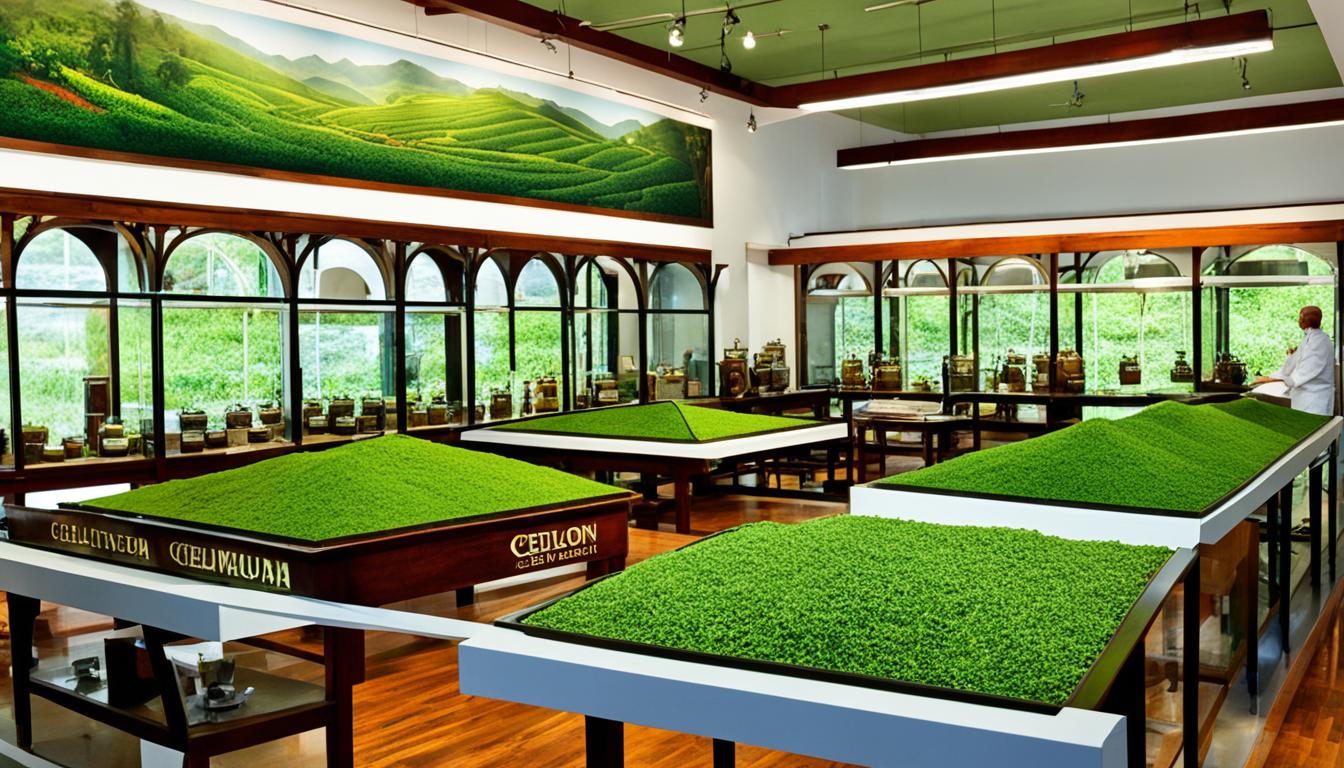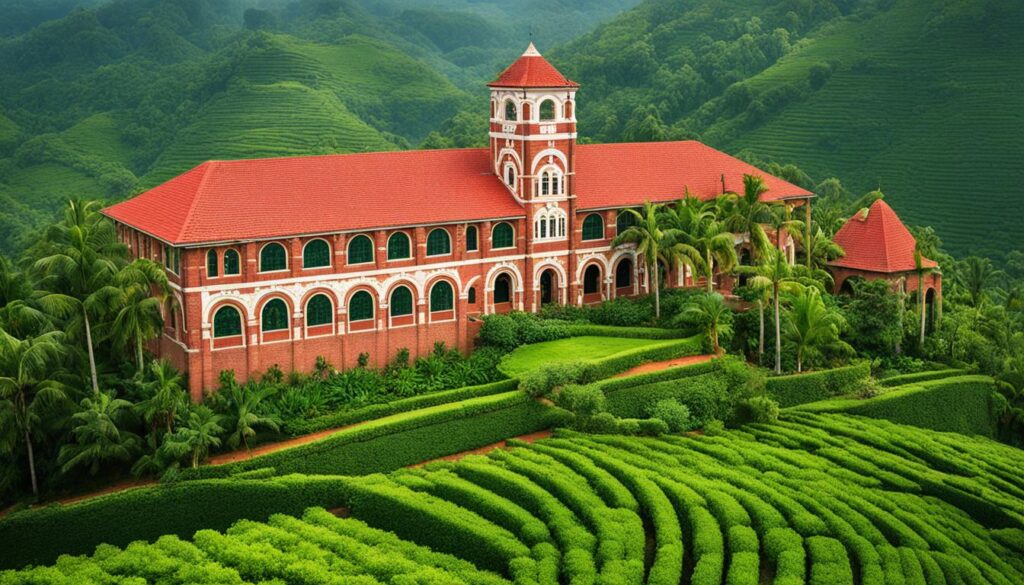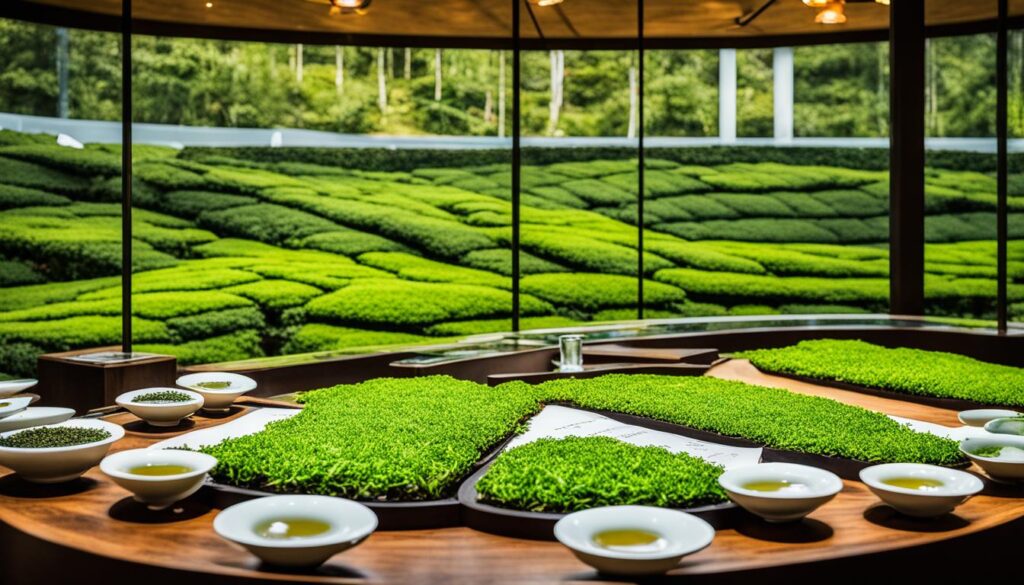
Discover Ceylon Tea Museum in Sri Lanka
In the green Hantana mountains of Sri Lanka lies a gem—the Ceylon Tea Museum. Stepping in feels like walking through history, welcomed by the scent of ancient tea. The museum, at the core of a nation known for exquisite tea, honors traditions and educates visitors.
This old tea factory now fascinates tourists with its mix of learning and peace. Touring Sri Lanka isn’t complete without exploring Ceylon tea’s legacy. The museum reflects this deeply. Beyond displays, it’s the history in the air, similar to the enduring aroma in tea aisles.
The story of Ceylon tea, from leaf to cup, is as captivating as tales of ocean journeys. The Ceylon Tea Museum, surrounded by Sri Lanka’s hills, is key to this story. It welcomes history fans and curious visitors to dive into the tea culture.
A Journey Back in Time: The History of Tea in Ceylon
The history of tea in Ceylon, now called Sri Lanka, is fascinating. This transformation turned the island into a top player in the tea industry. It changed the economy during the colonial times.
A Tale of Transformation: From Coffee to Tea
In the mid-19th century, a disease destroyed the island’s coffee plants. This led people to look for other crops. Tea became the chosen alternative. Pioneering planters and the island’s climate made this switch successful.
The Legacies of James Taylor and Thomas Lipton
James Taylor, known as the father of Ceylon tea, started the first successful plantation in 1867. His efforts and methods kickstarted the tea industry. Thomas Lipton built a tea empire, making Lipton Tea well-known globally. Their legacies live on in every cup of Ceylon tea.
Understanding Tea Cultivation through Epochs
Tea cultivation in Ceylon went through many phases. Each period added something new to the tea industry. From the colonial era’s beginnings, to post-independence innovations, to today’s focus on sustainability. These times show the industry’s growth and the people’s resilience.
| Epoch | Contribution to Tea Industry | Key Figures |
|---|---|---|
| Colonial Period | Foundation and expansion of tea plantations, infrastructure development | James Taylor, George Steuart |
| Post-Independence | Nationalization, introduction of research and innovation | D. W. R. Wickremasinghe, Merril J. Fernando |
| Modern Times | Adoption of sustainable and ethical practices | Sustainable Agriculture Network, Fair Trade movements |
The history of tea in Ceylon is deeply linked with Sri Lanka’s culture and economy. Even today, the tea industry shows the nation’s ability to adapt and persevere. This rich history continues to shape the world.
The Architectural Marvel: Ceylon Tea Museum Structure
In the hills of Kandy, the Ceylon Tea Museum structure is a witness to Sri Lanka’s colonial history. Standing on the Hantana Tea Factory site, this museum merges past and present beautifully. Its architecture tells a story of a rich legacy.
The Colonial Legacy of Hantana Tea Factory
Since the 1920s, the Hantana Tea Factory has been a key landmark. Its solid design showcases the engineering skills of that time. The red-brick outer walls and distinct design show British colonial influence on the tea industry.

Reviving the Abandoned: Museum’s Modern Renovation
The old Hantana Tea Factory was beautifully turned into the Ceylon Tea Museum. This makeover kept the colonial elegance but added modern features for displays and visitors. It perfectly blends the old with the new, celebrating the tea industry’s history and meeting today’s museum standards.
| Feature | Colonial Era Design | Modern Renovation |
|---|---|---|
| Exterior | Red-brick walls, large windows | Preserved, with structural reinforcements |
| Interior | Wooden beams, open spaces | Climate control, interactive displays |
| Space Usage | Tea processing and storage | Museum galleries, tea tasting area |
| Technology | Industrial-age machinery | Modern lighting, multimedia exhibits |
| Visitor Experience | Functional factory setting | Educational tours, gift shop |
The Ceylon Tea Museum structure tells two important stories. It shows Sri Lanka’s journey from colonial times to becoming a famous tea producer. It also shows how a neglected facility was transformed into a place that celebrates this heritage.
Savoring the Aromas: Tea Tasting and Purchases
When you visit the Ceylon Tea Museum, you start a journey of the senses. You get to try tea tasting, a way to tell different Ceylon tea flavors apart. It’s not just fun; it teaches you about Ceylon tea’s history too.

Tasting different teas helps you notice what makes each blend unique. This exploration of tea tasting includes the option to buy tea purchases. So, you can bring a piece of Sri Lanka’s tea culture home.
Through the ritual of tea tasting, connoisseurs and novices alike can appreciate the legacy preserved in every cup of Ceylon tea.
Choosing which Ceylon tea to buy can feel overwhelming. Below, we compare different Ceylon tea flavors. We also mention their unique traits and what foods they go well with.
| Ceylon Tea Type | Tasting Notes | Recommended Pairings |
|---|---|---|
| Ceylon Black Tea | Robust, full-bodied with citrusy hints | Rich desserts like chocolate cake |
| Ceylon Green Tea | Delicate, slightly spicy with a fresh finish | Seafood dishes or light salads |
| Ceylon White Tea | Sweet, silky with a note of honey | Fruit pastries or mild cheeses |
| Ceylon Oolong Tea | Complex, fragrant with a mild smokiness | Smoked meats or spicy food |
No matter if you’re there to learn, enjoy, or reminisce, the Ceylon Tea Museum has Ceylon tea flavors for tasting and buying that suit everyone’s taste, each person, and every special moment.
An Insider’s Look at Tea Production Processes
Start a fascinating journey into the tea production processes at the Ceylon Tea Museum. This unique place combines history with the present in an amazing way. Visitors get to learn about how tea is made.
Witnessing the ‘Little Giant Tea Roller’ in Action
At the museum’s core is the Little Giant Tea Roller. This original machinery is more than a historical piece. It shows the enduring legacy of the tea industry. Spectators are amazed as it processes the tea leaves. This step is crucial for creating famous Ceylon tea.
Fascinating Exhibits of Original Machinery
Further inside, visitors find a collection of original machinery. Each piece has been key in the tea production processes. These machines narrate the tale of a nation’s journey with tea.
| Machinery Exhibit | Role in Tea Production | Era of Origin |
|---|---|---|
| Tea Rolling Machines | Rolling dried leaves to initiate fermentation | 19th Century |
| Fermenting Bins | Controlled oxidation of tea leaves | Early 20th Century |
| Drying Ovens | Halting fermentation at the optimal time | Mid-20th Century |
| Sorting Machines | Grading tea leaves by size and quality | Late 20th Century |
Each exhibit highlights a part of tea making, telling Sri Lanka’s tea story. The Ceylon Tea Museum truly protects history, one leaf at a time.
Planning Your Visit: Tips and Best Practices
Getting ready for a Ceylon Tea Museum visit needs some planning for a great trip. Keep in mind these travel tips and best practices for a fun and smooth adventure.
First, check the museum’s hours as they change with the seasons. Make sure to plan enough time for a leisurely visit. The entrance fee is small but opens the door to a rich tea history. If you’re with others, consider getting a group pass for savings. You can learn more about visiting on the museum’s website or from local guides.
Figuring out how to get there is also key. The museum sits in the beautiful Hantana Mountain Range and is easy to reach by car or bus from Kandy. For those flying into Colombo’s Bandaranaike International Airport, you can take a train or taxi to Kandy next.
- Pack right by checking the local weather.
- Have a list of emergency numbers ready, including local help.
- Think about hiring a guide to learn more about the museum.
- Look at places to stay in Kandy to get a taste of the area.
When planning your Ceylon Tea Museum visit, remember Kandy has lots to see too. Don’t miss the Temple of the Tooth Relic, Royal Botanical Gardens, and the vibrant Kandy market. They all add to your museum trip.
Following these best practices will make your museum trip a deep dive into Sri Lanka’s prized tea history. Have a safe trip and enjoy exploring the world of Ceylon tea!
Conclusion
Exploring the Ceylon Tea Museum is not only a visit. It’s a deep dive into tea heritage in Sri Lanka. This place is a symbol of the country’s dedication to keeping and celebrating its history. It’s perfect for those who love cultural discoveries and the rich history tapestry.
Each room and exhibit tells the story of Ceylon tea in detail. This ensures every visitor leaves with a deeper respect for the tea industry. This industry has deeply influenced Sri Lanka’s economy and culture.
Sri Lanka shows off its history with the story of tea. The Ceylon Tea Museum is at the heart of this story. It brings visitors back to the old plantation days while showing the industry’s modern advancements. The museum is both enchanting and educational. It draws in tourists and tea lovers, helping them understand how tea is made. This is one of the world’s most cherished drinks.
The Ceylon Tea Museum has a lasting impact on visitors. It is a key part of tea history and Sri Lanka’s rich past. The museum shares the life stories of those who transformed tea into a worldwide sensation.
So, if you love tea, history, or unique travel experiences, this museum is for you. It offers a mix of learning and nostalgia. This makes your visit to Sri Lanka even more special.
FAQ
What is the Ceylon Tea Museum?
The Ceylon Tea Museum is a special place in Sri Lanka. It shows the deep history and culture of making tea in the country.
Where is the Ceylon Tea Museum located?
You can find the Ceylon Tea Museum in the old Hantana Tea Factory in Sri Lanka.
What can I learn about in the Ceylon Tea Museum?
At the Ceylon Tea Museum, you can discover the story of Ceylon tea. Learn how tea is made and try different Ceylon tea flavors.
What is the significance of the Ceylon Tea Museum?
This museum is important because it keeps and shows Sri Lanka’s tea culture. It’s a key cultural spot.
Can I purchase Ceylon tea at the museum?
Yes, you can taste many Ceylon tea flavors at the museum. And you can buy your favorite ones to take home.
Are there any nearby accommodations and attractions?
Yes, there are places to stay and things to see near the Ceylon Tea Museum. It’s great for visitors.
Source Links
- https://traveltriangle.com/blog/ceylon-tea-museum/
- https://www.lonelyplanet.com/sri-lanka/the-hill-country/kandy/attractions/ceylon-tea-museum/a/poi-sig/450795/357477
- https://www.makemytrip.com/tripideas/attractions/ceylon-tea-museum

Leave a Reply